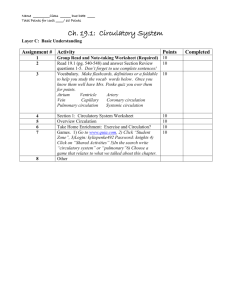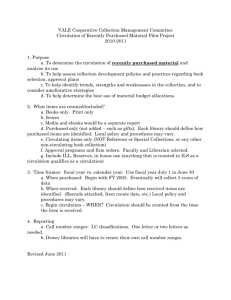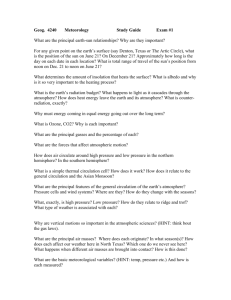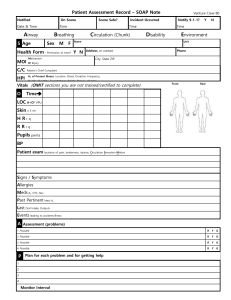The note circulation(1)
advertisement
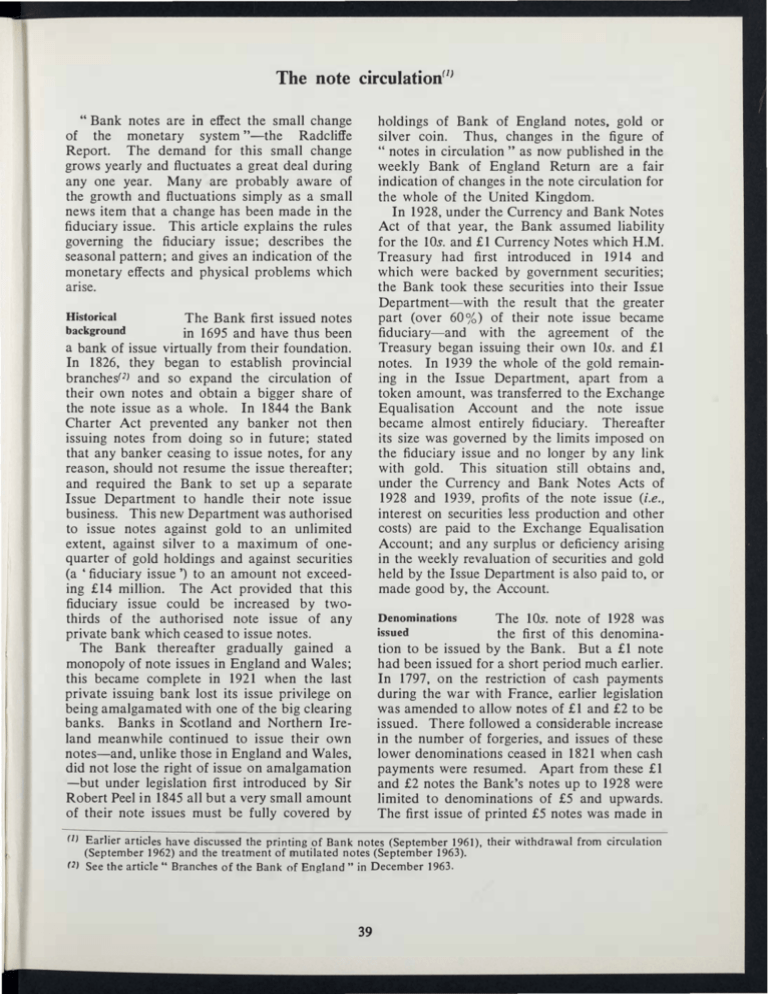
The note circulation(1) "Bank notes are in effect the small change holdings of Bank of England notes, gold or silver coin. Thus, changes in the figure of of the monetary system "-the Radcliffe Report. The demand for this small change grows yearly and fluctuates a great deal during " notes in circulation" as now published in the weekly Bank of England Return are a fair any one year. Many are probably aware of the growth and fluctuations simply as a small news item that a change has been made in the fiduciary issue. This article explains the rules governing indication of changes in the note circulation for the whole of the United Kingdom. In 1928, under the Currency and Bank Notes Act of that year, the Bank assumed liability the fiduciary issue; describes the for the IOs. and £1 Currency Notes which H.M. seasonal pattern; and gives an indication of the monetary effects and physical problems which Treasury had first introduced in 1914 and arise. which were backed by government securities; the Bank took these securities into their Issue Historical background part (over 60%) of their note issue became fiduciary-and with the agreement of the Department-with the result that the greater The Bank first issued notes in 1695 and have thus been a bank of issue virtually from their foundation. In 1826, they began to establish provincial Treasury began issuing their own 10s. and £1 notes. In 1939 the whole of the gold remain­ ing in the Issue Department, apart from a token amount, was transferred to the Exchange Equalisation Account and the note issue branches(2) and so expand the circulation of their own notes and obtain a bigger share of the note issue as a whole. In 1844 the Bank Charter Act prevented any banker not then became almost entirely fiduciary. Thereafter its size was governed by the limits imposed on issuing notes from doing so in future; stated that any banker ceasing to issue notes, for any reason, should not resume the issue thereafter; the fiduciary issue and no longer by any link with gold. This situation stilI obtains and, under the Currency and Bank Notes Acts of 1928 and 1939, profits of the note issue (i.e., and required the Bank to set up a separate Issue Department to handle their note issue business. This new Department was authorised to issue notes against gold to an unlimited interest on securities less production and other costs) are paid to the Exchange Equalisation Account; and any surplus or deficiency arising extent, against silver to a maximum of one­ quarter of gold holdings and against securities in the weekly revaluation of securities and gold held by the Issue Department is also paid to, or made good by, the Account. (a ' fiduciary issue ') to an amount not exceed­ ing £14 million. The Act provided that this fiduciary issue could be increased by two­ thirds of the authorised note issue of any private bank which ceased to issue notes. The Bank thereafter gradually gained a Denominations issued The 1Os. note of 1928 was the first of this denomination to be issued by the Bank. But a £1 note monopoly of note issues in England and Wales; this became complete in 1921 when the last private issuing bank lost its issue privilege on being amalgamated with one of the big clearing banks. Banks in Scotland and Northern Ire­ had been issued for a short period much earlier. In 1797, on the restriction of cash payments during the war with France, earlier legislation was amended to allow notes of £1 and £2 to be issued. There followed a considerable increase in the number of forgeries, and issues of these lower denominations ceased in 1821 when cash payments were resumed. Apart from these £1 and £2 notes the Bank's notes up to 1928 were limited to denominations of £5 and upwards. The first issue of printed £5 notes was made in land meanwhile continued to issue their own notes-and, unlike those in England and Wales, did not lose the right of issue on amalgamation -but under legislation first introduced by Sir Robert Peel in 1845 all but a very small amount of their note issues must be fully covered by (1) Earlier articles have discussed the printing of Bank notes (September 1961), their withdrawal from circulation (September 1962) and the treatment of mutilated notes (September 1963). (2) See the article" Branches of the Bank of England" in December 1963. 39 1793 and notes of this denomination have been issued ever since. The first issue of printed £10 notes was in 1759. This denomination, along with those for £20, £50, £100, £500 and £1,000, was discontinued in 1943 to provide an addi­ tional handicap to those contemplating breaches of exchange control regulations and 'black market' transactions. The £10 note was revived in modern form in February 1964. Other denominations of printed notes which have been issued are £15, £25, £30, £40, £60, £70, £80, £90, £200, £300 and £400: all these were discontinued before the end of the nineteenth century, except for the £200 note which remained until 1928. but do not require pOSltlve approval though either House may review and, if thought fit, annul them. Thus parliamentary control of the fiduciary issue is now confined to a veto on increases, exercisable every two years. And the statutes implicitly recognise that, while ultimate control must rest with Parliament, the economic significance of the note circulation is much reduced. Fluctuations in the circulation Two kinds of fluctuation in the circulation may be distinguished. First, within each week and month there are variations associated with pay­ ments of wages and salaries and with the return of notes from shopkeepers to their bankers. Secondly, there are three major peaks and troughs in the note circulation in the year, Parliamentary control always has Parliament maintained control over the growth of the fiduciary note issue, although its interest has varied over the years with the changed importance which has been attached to occurring around the holiday periods of Christ­ mas, Easter and August, with a smaller fluctua­ tion around Whitsun. It is these peaks and troughs which in practice are the occasion for changes in the fiduciary issue. Their extent the level of the note circulation. In the past the view was widely held that expenditure could be restricted or stimulated by manipulat­ ing the permitted level of the circulation. But the increase in other forms of government debt and the growth of other means of payment, such is illustrated in Chart 11 at the end of the article. Mechanics of issue In order to explain the implications of these fluctuations it is necessary first to say a word about as bank deposits, have shifted the emphasis of monetary policy away from notes. The Act of 1928 specified a fiduciary issue the mechanics of issue. Although the Bank of England will supply notes to anyone against payment, the first not exceeding £260 million; this was increased by the 1939 Act to £300 million-a figure which impact of changes in the public's demand for notes in practice falls on the commercial banks in England and Wales. The banks absorb some might, with Treasury authority, be exceeded but not continuously for longer than two years without parliamentary approval. Under the provisions of the Defence (Finance) Regula­ tions, 1939, the period of two years was indefinitely extended. Further legislation came of the fluctuations in demand by keeping stocks of notes in their tills; and frequent transfers are made between branches-whether of a single bank or of different banks-some of which may pay out more notes than they receive while others pay out less. In recent years the level in 1954, with the Currency and Bank Notes Act of that year; and this is the principal statute now governing changes in the fiduciary note issue. The Act provides for a fiduciary issue of £1,575 million (the actual amount of the issue when the Act passed through Parliament) and allows the Treasury to vary this amount at the instance of the Bank. No continuous increase above £1,575 million is permitted for longer than two years, unless the Treasury direct that this period be extended or further extended by a similar period; this has been done by Fiduciary Note Issue (Extension of Period) Orders in every second year since 1956. These Treasury Orders must be laid before Parliament of tills, while fluctuating considerably with the demand expected by the banks, has remained on average about 15% of the total circulation shown in the weekly Bank Return. The banks get their supplies of new notes and dispose of their holdings of worn and dirty notes by transfers in bulk from or to the Bank of England-in London or at the Bank's pro­ vincial branches-against settlement through their accounts with the Bank. For the Bank, a rise in the note circulation appears· as an excess of new notes issued and a fall as an excess of old notes paid. To provide a cushion 40 As against very short-term fluctuations the Bank­ ing Department holds a stock of notes. But explained in the article "The March 1963 issue, the Bank's management of the London money market involves, in part, estimating transactions affecting the balances when variations in demand are larger than can be met by, or reasonably absorbed into, the Banking Department's holding it has to be replenished or reduced. This is the occasion of banks with the Head Office of the Bank and relating those transactions to a daily 'target' for their balances which the banks fix in advance. But these balances form only a part of the banks' cash which they aim to keep at for changes in the fiduciary issue, usually in amounts of £50 million at a time. The timing of these changes depends on the level of notes held by the Banking Department and on pros­ pective demand. 8% of their gross deposits. The other main element is notes in their tills. Tills are affected by two flows of notes: that between the Bank­ There is a store of notes into which they are taken when first printed to provide a reserve against seasonal fluctuations and possible inter­ ing Department and the banks and that between the banks and the pUblic. Both flows can affect bankers' balances. For example, a flow of notes from the Banking Department to the banks' tills will alter the composition of their cash and lead ruptions in the supply from the Bank's Printing Works. If the Banking Department's holding requires replenishing because the circulation is rising, notes are withdrawn from the store, added to the fiduciary issue (and thus to the them to reduce their ' target' for balances with the BankP) A flow of notes from the banks' tills to the public will lead to an equal reduction in their deposits and their cash, tending to reduce their cash ratios. The banks will then liabilities of the Issue Department) and sold to the Banking Department . (The Issue Depart­ ment's assets increase correspondingly as it receives payment, in Treasury Bills, from the Banking Department) Conversely, if the Bank­ ing Department's holding!I) needs to be reduced, have to restore these ratios by raising their bal­ ances, probably in the first place by withdraw­ ing call money from the discount market, so notes are returned to the store and the fiduciary issue and the liabilities and assets of the Issue Department are reduced. Mone�ry effects was management of money day by day" in the that there will be a shortage of funds in the market, which can be met by the authorities' purchasing Treasury Bills. Looking at these movements of notes as a A change in the fiduciary whole, including changes in the fiduciary issue, issue has by itself no monetary effect, except, as mentioned below, to it can be seen that a change in the demand for notes can alter the Exchequer's need to borrow on other forms of debt. In terms of Table 1 of the statistical annex this is reflected either in a change in the composition of " net change the overall cost of Exchequer borrow­ ing. The transfers of notes between the Bank­ ing Department and the Issue Department are, �s already mentioned, effected against payment Thus, when the fiduciary indebtedness to the Banking Department" or in III Treasury Bills. changes in notes in circulation and in non­ marketable and marketable debt. As all forms of Exchequer debt available to the public, other issue is altered, all that happens at that stage is a change in the form of borrowing by the Exchequer Group (of which the Issue Depart­ ment forms part) and a switch in the assets of the Banking Department from Treasury Bills to notes or conversely. The significant movements, . WhICh are taking place all the time, whether the fiduciary issue changes or not, are those between the Banking Department and the com­ than notes, are interest-bearing, a rise in the demand for notes tends to reduce, and a fall to increase, the cost of borrowing. The physical problem mercial banks, and between the commercial banks and the general public . For the Bank, servicing the note circulation involves printing, examining, counting, transporting and issuing, through their Head Office or their (1) Although the. Banking Department receives old notes paid in by the banks, its holding is always, by appropnate adjustments, kept in the form of new notes. practice complications arise because, as explained earlier, part of the flow of notes (and initial settlement erefor) takes place through the Bank's branches whereas market management is conducted in relation to Head Office balances. (2) tIh 41 branches, over 2,000 million new notes each year. A similar number of worn and dirty notes has to be paid, transported, counted, examined and destroyed. The volume of paper involved amounts each year to about 4,000 tons. By some standards this is no great weight, been explained earlier, the impact of these fluctuations on production capacity is cushioned by variations in the store of new notes available for issue. Similarly there is a variable stock of paid notes awaiting examination and destruc­ tion. But this does not ease the problems of but the special problems which arise can be appreciated if it is remembered that a given package of even the lowest denomination note is worth very much more than its weight in gold. those who have to count, transport and safe­ These include guard both flows of notes. the commercial banks, the police and many carriers. The size of this problem is affected by various factors, some of them conflicting. The value of the note circulation tends to rise each year with Regional distribution Rather more than 50% of all notes issued or withdrawn from circulation pass through the Bank's branches. In general the flow of notes the money value of transactions. In recent years, as illustrated in Chart Ill, this has not had a proportionate effect on the number of pieces of paper required because public demand in the several areas served by the Bank's branches does not differ greatly over the year from that at Head Office. However, while the has shifted in favour of the £5 note following its change to a more convenient size in 1957. More recently the new £10 note has begun to have a similar, although so far much smaller, effect. A continued change in this direction would help to minimise the manpower and other resources needed to provide the public with the note circulation which it appears to require. note circulation as a whole has normally risen to its main annual peak at about Christmas, the outflow of notes from the Bank's branches has been at its maximum at about the end of July. This can probably be explained by differing social habits; for example, the concentration of holiday expenditure through the complete closure of entire industries in some Northern and Midland areas for one or two weeks. This interpretation of the figures receives some sup­ port from the fact that the prominent end-July peak in issues from the Bank's branches as a On the other hand, as shown in Chart IV, there has been a marked decline in recent years in the average life of notes: this applies parti­ cularly to the lower denominations, the average life of a £1 note being about nine months whereas that of a £5 note is some fifteen months. Crisp new notes, rather than merely clean ones, are pleasant to receive and easier to handle and count by machine; and many individuals and firms prefer them. But in the whole, while marked in Manchester, Birming­ ham, Leeds and Newcastle, is relatively small in Bristol and Southampton. differences some interesting are There between metropolitan and regional habits as regards note denominations. Londoners appear to make more use of 10s. notes, for-unlike the int�rest of economy in production and distribu­ tion-and in the interest of security where the movement of large consignments of notes is concerned-it is desirable that notes should remain in use for longer than they do at present. other values-a majority of 10s. notes begin and end their circulation life in London. The branches' appetite for £5 notes is notably A further minor bigger than London's. mystery is that, while only 38 % of the £10 notes so far circulated were issued at the branches, 62% of those withdrawn from cir­ Within these general problems of growth the Bank, like others, face those arising from peak­ loads on capacity of both staff and equipment, therefore not and specialised is which For immediately adaptable to other uses. example, in the four weeks preceding the peak of the note circulation just before Christmas 1964,226 million new notes were issued and 136 million received for payment and destruction. In the four weeks covering the post-Christmas decline, new notes issued fell to -¥n million but old notes received rose to 220 million. As has culation were paid at them: it may be that many people in the home counties, when they go on holiday elsewhere in Britain, finance themselves with £10 notes. Another regional phenomenon is the rela­ tively large demand for notes of the higher values from the Bank's Birmingham branch. More than half of the value of notes issued there in 1964, for instance. was in £5 and £10 � for 172 read 127 42 denominations, compared with an average of 40% at the other provincial branches. notes; industrial disputes, most recently the postal dispute in July 1964, may also have a short but marked effect. As explained earlier, the impact of seasonal This may reflect differences in money wages or in practices in making up wage-packets, through which a large proportion of new notes passes into the hands of the public. Forecasting variations in the note issue on production of new notes and on examination and destruction of old notes is partly cushioned by changes in stocks. Forecasts of the behaviour Much more important in this connec­ tion are long-term trends. So far as the value of the circulation is concerned certain of the note circulation are required both in looking ahead at the likely state of the money market and the banking system, and in planning established relationships can be used, such as that between it and the value of consumers' expenditure. This relationship is illustrated in for the production and destruction of notes. In looking at the money market and the banking system the main concern is short-term estimates of seasonal movements. For this purpose a fifty-two-week moving average of Wednesday figures is used to assess the under­ lying trend in the total note circulation, the actual level in any one week or at any particular season then being expressed as a percentage Chart 1. Each point shows the value of con- Chart I Note circulation!consumers' expenditure 1955-1963 circulation y (Annuol overage) £ millions Note deviation from this moving average. The latter increases at a fairly steady rate and it is rela­ tively easy to project it forward. One may thereafter, by examining the seasonal pattern in years when holidays fell at about the same time 2,500 2,300 2.300 in the year, estimate future deviations from the average (see Chart II). 2,100 2,100 1,900 1,900 The method of estimation for holiday peaks be further improved-particularly at could 2,500 y=349.S.0.1107x Easter-if the holiday effect could be separated from the normal monthly pattern. It would then be possible, for example, to use the 1.700 L..----.l_-.L_-.L_-.L_--L_L-_L--.l1. 700 evidence of all recent Easters in assessing the current pattern, instead of having to confine attention to 'similar ' years. Further work is being done on this. Standard error of equation, s = 16'3 (see definition in footnote on page 34). 12 14 15 16 17 20 x consumers' expenditure The figures for 1962 and 1963 have been adjusted to neutralise the estimated effects of the recall of Series A £1 notes. For the daily management of the money market these short-term estimates can be sumers' expenditure and the average note cir­ culation for a particular year. These points all lie near a straight line, indicating a strong correlation; thus on any given assumption con­ cerning consumers' expenditure it is possible to forecast a value for the circulation. But to revised frequently in the light of the notifica­ tions received from banks of their requirements of new notes and transfers of old notes. Forecasts are also needed of irregular and non-recurring influences which may have a significant effect upon the pattern and size of movements in the circulation. The withdrawal advance from this to a forecast of the capacity required for production and destruction is a complex problem which falls outside the scope of this article. Such a forecast must take account not only of the demand for notes of different denominations, existing or new, and the life of notes, but also of the future of the currency unit, of the coinage and of prospective developments in methods of money transfer. from circulation of the old series £1 note caused large quantities of hoarded notes to be paid into banks; and the new £5 note issued in 1963 provoked a small and short-lived expansion in the value of the note circulation. 13 Thousands An influence which could not be foreseen was the effect on retail trade of the severe winter of 1962-63, which delayed the normal spring outflow of 43 Chart 11 Notes in circulation Easter and Whitsun Average of years 1931/1964 27th -29th March 91h -10th April 21st- 22nd April -t- in which Easter Sunaay fell on: Per cenl deviations from moving average +1 7 o . . . . -1 -2 . .. . . .. . . ... . . .. . . �=��.�=�:�;::.::....... . . . . . . . . .. Easter .. . .. .. . .• .. • ••.•.•. . • . .. . . . __ __ __ __ __ __ - 1 . . - 3LL- �L--L L- � __� � � 5th 41h 's �t� 3rd 2n d=!st � WednesdaysV after Easter Wedn�sdayS before Easter __ __ 0 -- __ __ � 6th ____ __ __ -2 Whitsun �� � � 1st Weds. 2nd '-----y-----' before Wednesdays Whitsun after Whitsun ____ __ __ __ _J- 3 ____ Christmas Average of years 193//1964 in vvhich 25th December fell on: Sunday/Monday Friday Per cent deviations from moving average +4 +4 +3 +3 +2 +I 0 -1 -2 -3 Nov. __ 2-} � L� L22 /29 Wednesdays falling: � __ I� ____ ____ � 13 �Dec.6 � -L August Averoge 1933/37 Average 1960/64 +5 �-3 __ L-__� __-L __ L--L 1st � 2n 18/ "" 2nd 1st ;.cd=-_3=-:rd "------y--' /Jan. 24 Weds.�fter Weds. before Christmas Christmas __ __ __ __ bank __ __ holiday Per cent deviations from moving overage +5 .4 ·3 ·2 • June 2ft. 6/ 20/ 73 / '.1uly5 /,2 �9 �6 Wednesdays falling: 2"?,, 3/ �ug.2 /9 44 I� 16 223 2j(30 � Sept.6 1 Chart III Percentage of total circulation(a) B 1 ____aI1__ 1951 End -February 1964 Chart IV Average life and value(a) Months [1:12:6 r------.---,--r 18 £1 :10:0 Average life of notes '�ight-hand scal� [1 :7:6 , --- �� � Series B £5 note issued ______ _ I ��� � [1: 5:0 16 4 �-.... £1:2:6 .... ....--.... .... b���::::.:E::::.:c::::�:===�::==Jl��������Jl��������;c:--�--� .... [ 1:0:0 1951 1952 1953 End - February 1960 (a) Excluding notes over £1,000, which are used by the Bank for internal purposes. 45

